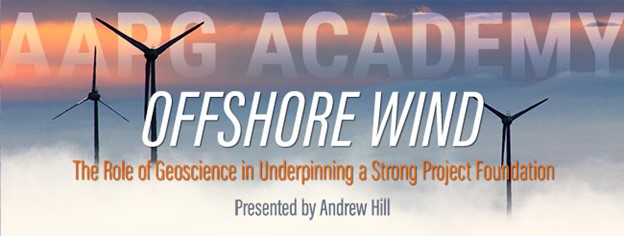
Offshore Wind: The Role of Geoscience in Underpinning a Strong Project Foundation
The AAPG Academy is hosting a free webinar via Zoom on Wednesday, October 4th at 12:00 pm entitled, "Offshore Wind: The Role of Geoscience in Underpinning a Strong Project Foundation" presented by Andrew Hill.
REGISTER NOW TO ATTEND
Webinar Abstract: The take-up of offshore wind as a source for electricity is accelerating globally across a variety of geologic settings. The scope and scale of these projects is enormous and foundation engineering of these projects can account for greater than 35% of gross project costs. . Whereas a major offshore oil and gas development might require the installation of four or five drill centers - be they from fixed platforms or subsea manifolds - and associated in-field and export pipelines and umbilicals, an offshore wind farm may require the installation of over a hundred turbines together with offshore substations, offshore convertor stations, intra array cables and export cables to shore. To be successful, therefore, projects require front end loading of geoscience input to understand overall setting, variability and implication to foundation concepts, followed, post license award, by intensive geophysical activity to accurately map site variability to develop a shallow geologic model, calibration by borehole ahead of final foundation choice.
Webinar Speaker: Andrew Hill
BP - Engineering Technical Authority for Marine Geohazards
Fellow of the Society for Underwater Technology - US
Andy W. Hill is the Engineering Technical Authority for Marine Geohazards for BP. He is currently Chair of the OSIG Houston Committee, having been the founder of the committee in 2007. He has been a member of the UK equivalent committee since 1990. He was made a Fellow of the SUT in 2020. He has 38 years of experience in Geophysical Site Investigation, the last 32 with BP. In 1997 he championed the introduction of AUVs into deep water site investigation triggering a step change in deliver after their introduction in 2000-01. He has worked on projects globally and introduced or championed some of the most significant developments in geophysical site investigation. He has published widely on the subject and been director or contributor to numerous industry documents.
Hosted by AAPG and Tulsa Geological Society
Sponsored by Drill2Frac and Commit